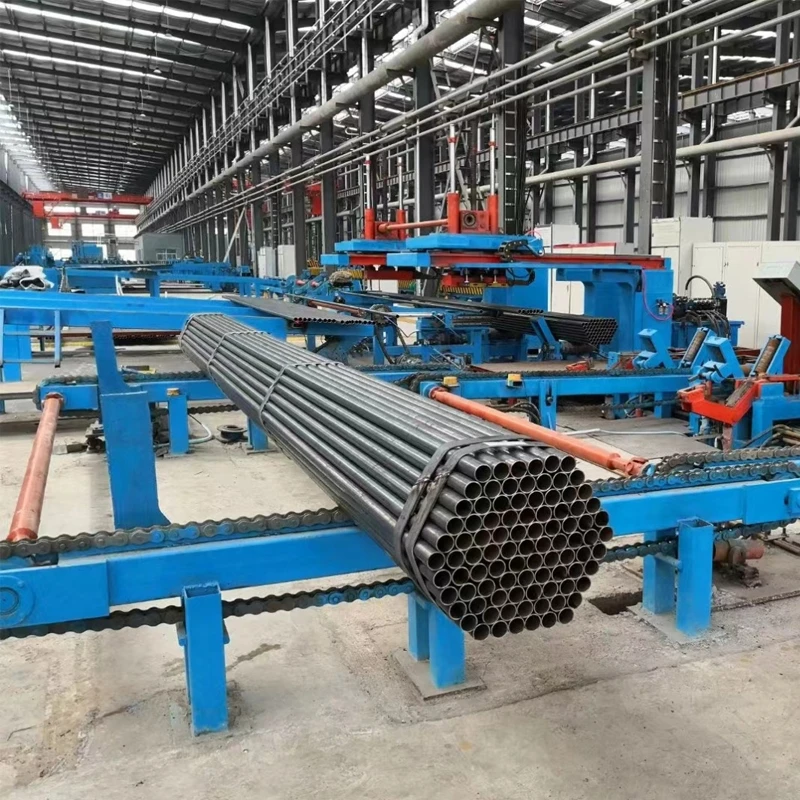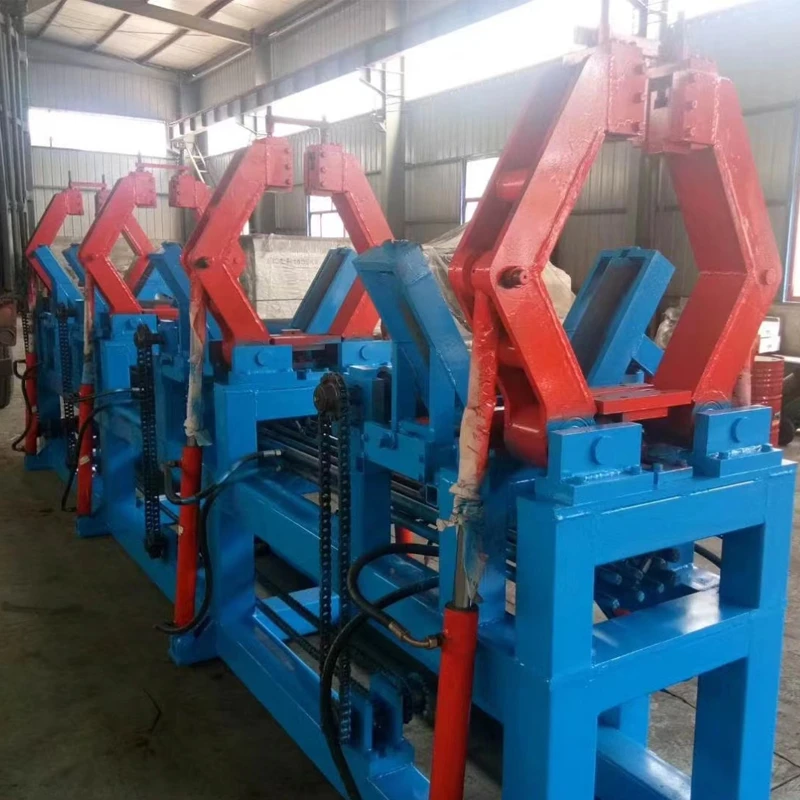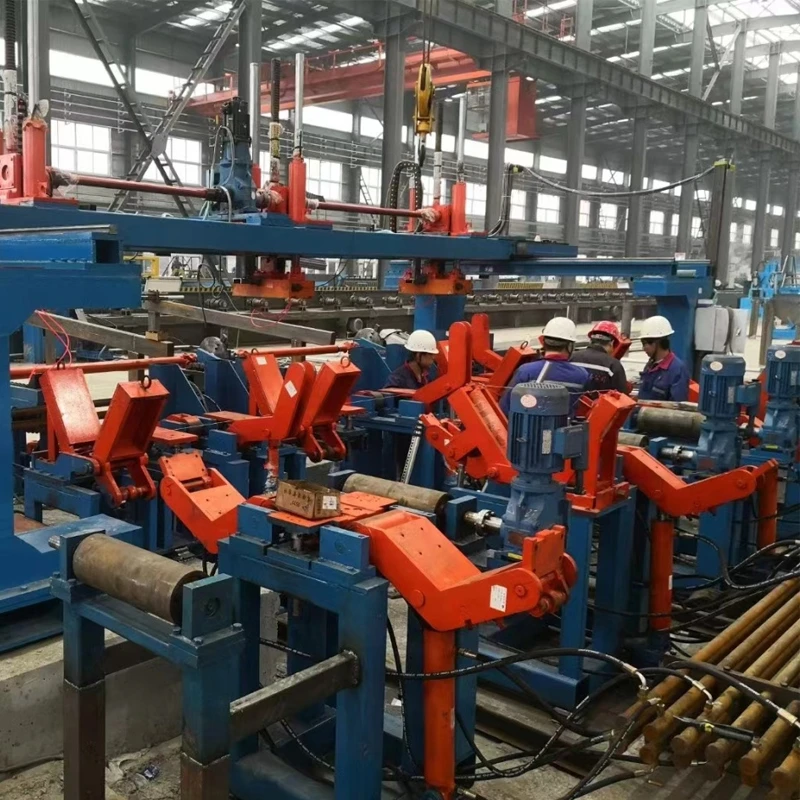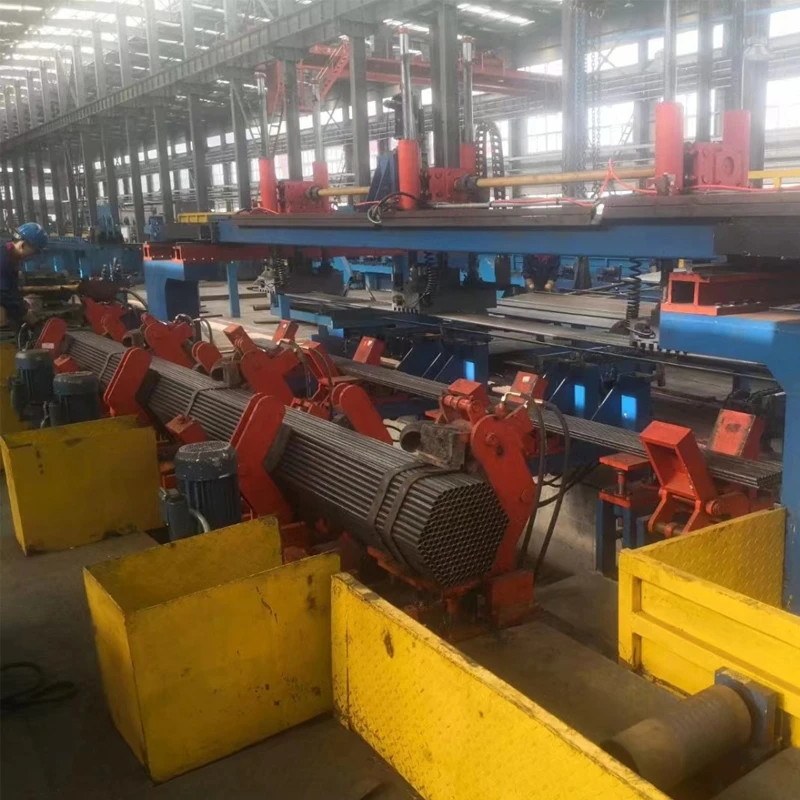High-Efficiency Automatic Belling Machine for Pipes
Driving Precision: An In-Depth Look at Belling Machine Technology and Market Trends
In the realm of pipe manufacturing, the efficiency and precision of end-forming processes are paramount. A critical component in this ecosystem is the belling machine, a specialized industrial apparatus designed to create flared or socketed ends on pipes, facilitating secure and leak-proof joint connections. This technology is indispensable across numerous industries, ensuring the seamless integration of piping systems. The global market for pipe manufacturing equipment, including belling machines, is experiencing robust growth, driven by increasing infrastructure development, urbanization, and demand for efficient fluid transfer solutions.
Industry trends indicate a clear shift towards higher automation, greater energy efficiency, and enhanced precision in belling operations. Manufacturers are increasingly integrating advanced control systems, such as PLC and HMI interfaces, to optimize cycle times, reduce material waste, and improve operational safety. The adoption of smart manufacturing principles, including predictive maintenance and real-time data analytics, is also on the rise, allowing for proactive intervention and maximized uptime. Furthermore, there's a growing emphasis on versatility, enabling a single belling unit to process a wider range of pipe materials and diameters, from PVC and PE to steel and composite pipes. These advancements are crucial for meeting the stringent quality standards and rapid production demands of modern industrial applications, including those served by complementary machinery like the purlin machine, shutter machine, and erw pipe machine, all contributing to a comprehensive industrial manufacturing ecosystem.

The Precision Engineering of a Belling Machine: Process Flow and Standards
The manufacturing process orchestrated by a belling machine is a sequence of highly controlled operations designed to achieve precise pipe socket formation. Understanding this process is key to appreciating the engineering expertise embedded in these machines.
Detailed Process Flow:
- Pipe Loading and Clamping: Raw pipes, often extruded from materials like PVC, PP, PE, or steel alloys, are automatically fed into the machine. A robust clamping mechanism, typically hydraulic or pneumatic, secures the pipe to prevent movement during the belling operation. This stage demands precision alignment to ensure concentricity of the bell.
- Heating (for Thermoplastics): For thermoplastic pipes, the end to be belled is heated to a specific, controlled temperature, typically using infrared heaters, hot air, or oil baths. This softens the material, making it pliable for deformation. Temperature uniformity and precise control are critical to prevent material degradation or uneven belling.
- Belling/Forming: Once the pipe end reaches the optimal temperature (for thermoplastics) or is positioned for cold forming (for metals), a belling mandrel, precisely machined to the desired bell profile, is inserted into the pipe. The mandrel expands, deforming the pipe end into the socket shape. This process can involve single-stage or multi-stage belling, depending on the complexity of the desired socket.
- Cooling (for Thermoplastics): After forming, the newly belled end of a thermoplastic pipe is rapidly cooled, often using forced air or water spray. This solidifies the material in its new shape, preventing shrinkage or deformation. Controlled cooling rates are vital to maintain dimensional stability and mechanical properties.
- Unclamping and Ejection: Once the belling process is complete and the pipe is sufficiently cooled, the clamping mechanism releases the pipe, and it is automatically ejected or transferred for further processing, such as stacking or packaging.
Materials, Manufacturing, and Testing Standards:
- Product Materials: The structural components of belling machines, including frames, mandrels, and clamping jaws, are typically fabricated from high-strength steel alloys (e.g., Q345B, S355JR) for durability and rigidity. Mandrels often use tool steels (e.g., Cr12MoV, D2) or hardened stainless steel for wear resistance and precision shaping.
- Manufacturing Processes: Key components undergo sophisticated manufacturing processes. Frames may be welded structures, stress-relieved to ensure stability. Mandrels and critical tooling are subjected to high-precision CNC machining (Computer Numerical Control) to achieve micron-level tolerances, ensuring consistent bell geometry. Hardening and tempering treatments are applied to tooling for extended service life.
- Testing Standards: Belling machines and their output pipes adhere to stringent international standards. For machine construction and safety, ISO 12100 (Safety of Machinery) and CE directives are common. For the pipes themselves, dimensional accuracy of the bell is checked against standards like ISO 3127 (PVC-U Pipes - Physical Characteristics) or ASTM F1970 (Plastic Pipe for Pressure Applications). Material integrity of the belled section is also verified.
- Service Life: With proper maintenance and use of high-quality components, a modern belling machine can achieve a service life exceeding 15-20 years, even under continuous operation. Critical wear parts like mandrels may require periodic replacement, but the core mechanical and control systems are built for longevity.
Target Industries and Application Advantages:
Belling machines are fundamental to industries requiring robust and reliable pipe joining.
- Water Supply & Drainage: Essential for PVC and PE pipe production for municipal water networks, sewage systems, and irrigation. Advantages include ensuring leak-proof joints critical for public health and preventing water loss.
- HVAC & Construction: Used for creating custom pipe sections for ventilation, heating, and cooling systems, as well as electrical conduits.
- Petrochemical & Metallurgy: While less common for the primary belling of large steel pipes (where specialized flaring equipment or welding is more prevalent), smaller diameter process pipes might use variations of belling or swaging. The principle of precise end-forming is applied here for specialized connections.
Typical advantages in these scenarios include energy saving through optimized heating and cooling cycles, and enhanced corrosion resistance in the finished joint, as the belling process itself does not introduce new materials or welding seams that could compromise material integrity, especially for non-metallic pipes. The precision belling ensures a tight fit, often compatible with rubber gaskets, forming a durable seal.
Technical Specifications of Advanced Belling Machines
Modern belling machine systems are engineered for high performance, reliability, and adaptability. Below is a representative table outlining key technical parameters for a typical high-volume PVC pipe belling machine. These specifications highlight the capabilities crucial for B2B decision-makers.
| Parameter | Specification | Details / Value Range |
|---|---|---|
| Pipe Diameter Range | DN 50 - DN 400 mm | (e.g., PVC-U, PP, PE pipes) |
| Wall Thickness Range | 2.0 - 18.0 mm | Adaptable to various pressure classes (PN 6 - PN 25) |
| Belling Type | Solvent Cement Socket / Rubber Ring Gasket Socket (RRG) | Configurable via quick-change tooling |
| Heating Method | Infrared (IR) with Ceramic Heaters | PID temperature control, uniform heating |
| Cooling Method | Forced Air Cooling / Water Spray Cooling | Temperature sensors for optimal cooling |
| Cycle Time (per pipe) | 20 - 60 seconds (diameter dependent) | High-speed modes for smaller diameters |
| Power Consumption | 15 - 30 kW (average during operation) | Energy-saving modes available |
| Control System | Siemens/Allen-Bradley PLC with HMI | Multi-language support, recipe management |
| Air Pressure Requirement | 0.6 - 0.8 MPa | Minimum flow rate 0.5 m³/min |
| Dimensions (L x W x H) | Approx. 4000 x 1500 x 2000 mm | Varies by model and capacity |

Application Scenarios and Technical Advantages
The versatility of the belling machine makes it a cornerstone in various pipe manufacturing and processing lines. Its technical advantages translate directly into operational efficiencies and product quality improvements across diverse applications.
Key Application Scenarios:
- PVC Pipe Production Lines: The primary application, where belling machines are integrated at the end of extrusion lines to produce PVC-U, PVC-O, and C-PVC pipes with precisely formed sockets for water supply, sewage, and drainage systems.
- PE/PP Pipe Systems: For polyethylene and polypropylene pipes used in gas distribution, industrial applications, and agricultural irrigation, belling creates fusion-ready or gasketed joints.
- Electrical Conduit Manufacturing: Producing conduits with flared ends allows for easy insertion of subsequent pipe sections, streamlining installation in electrical wiring infrastructure.
- Custom Pipe Fabrication: For specialized projects requiring non-standard pipe lengths or specific connection types, these machines offer the flexibility to bell pipes on demand, reducing the need for costly custom fittings.
Core Technical Advantages:
- High Precision and Consistency: Advanced servo-motor control and finely machined mandrels ensure repeatable bell geometry, dimensional accuracy, and consistent socket depth, critical for reliable joint performance. This reduces field fitting issues and enhances system integrity.
- Optimized Production Speed: Automated feeding, precise heating, rapid forming, and efficient cooling cycles minimize overall cycle time, maximizing throughput and reducing per-unit costs. This is essential for high-volume manufacturing environments.
- Versatility and Adaptability: Modern belling machines can often handle a wide range of pipe diameters and wall thicknesses with minimal changeover time, thanks to quick-change tooling systems and programmable settings. This flexibility is vital for manufacturers producing diverse product lines.
- Energy Efficiency: Intelligent heating systems with zone control and effective insulation minimize heat loss. Regenerative braking systems and optimized motor controls contribute to lower power consumption, reducing operational expenses and environmental impact.
- Enhanced Safety Features: Integrated safety interlocks, emergency stop buttons, and robust guarding mechanisms protect operators and comply with international safety standards (e.g., OSHA, CE directives), ensuring a secure working environment.
- Reduced Labor Costs: Automation significantly reduces the need for manual intervention, minimizing labor costs and the potential for human error. Operators can supervise multiple machines, improving overall plant efficiency.
These advantages collectively position advanced belling machines as critical investments for pipe manufacturers striving for competitive edge, operational excellence, and adherence to the highest quality benchmarks, complementing the capabilities seen in other specialized equipment like the purlin machine and shutter machine within broader industrial fabrication settings.
Vendor Comparison for Belling Machine Solutions
Selecting the right belling machine vendor is a strategic decision that impacts long-term operational efficiency and return on investment. Below is a comparative analysis of hypothetical vendors, highlighting key differentiators that B2B buyers consider.
| Feature/Criteria | Vendor Alpha Solutions | Vendor Beta Innovations | Vendor Gamma Dynamics |
|---|---|---|---|
| Automation Level | Fully Automatic (PLC + HMI, Robotic Arm Ready) | Semi-Automatic (PLC with manual loading/unloading) | Advanced Automatic (AI-powered predictive maintenance) |
| Pipe Diameter Range | DN 50 - DN 315 mm | DN 75 - DN 250 mm | DN 160 - DN 630 mm (Heavy-duty) |
| Material Compatibility | PVC, PE, PP | PVC only | PVC, C-PVC, ABS, PE, PP (with specialized mandrels) |
| Cycle Time (DN 110) | ~25 seconds | ~35 seconds | ~20 seconds (optimized for speed) |
| Customization Options | Moderate (tooling, software settings) | Limited (standard models) | Extensive (full line integration, special profiles) |
| After-Sales Support | 24/7 Remote, On-site within 72h | Business Hours Phone, On-site within 5 days | Dedicated Account Manager, Global Service Network |
| Certifications | CE, ISO 9001 | CE | CE, UL, ISO 9001, TÜV |

Customized Solutions and Application Case Studies
While standard belling machine models cater to most needs, specific production requirements often necessitate tailored solutions. Manufacturers with extensive experience excel in providing bespoke machinery, integrating seamlessly into existing or planned production lines.
Customized Belling Solutions:
Customization options extend beyond basic tooling adjustments. They can include:
- Specialized Material Handling: For highly flexible pipes (e.g., corrugated) or very rigid materials (e.g., certain composites), custom loading and clamping mechanisms ensure precise positioning without damaging the pipe.
- Unique Bell Profiles: Beyond standard solvent or rubber ring sockets, certain applications require unique bell shapes, specific internal grooves, or multi-stage belling for enhanced sealing or structural integrity. Custom mandrel design is crucial here.
- Integrated Automation: Full integration with upstream extrusion lines (e.g., cutting, chamfering) and downstream stacking or packaging systems, featuring robotic interfaces and synchronized control systems for lights-out manufacturing.
- Environmental Adaptations: Machines designed for extreme operating conditions, such as high humidity, corrosive environments, or cleanroom requirements, necessitate specialized componentry and protective coatings.
Application Case Studies:
Real-world applications underscore the impact of advanced belling technology:
Case Study 1: Large-Scale Municipal Water Infrastructure Project
A leading pipe manufacturer in Southeast Asia secured a contract for a major municipal water distribution network, requiring high volumes of PVC-U pipes (DN 200-400mm) with specific rubber ring gasket (RRG) sockets. They deployed a high-speed, fully automated belling machine system with integrated cooling and stacking. The system's ability to maintain a consistent cycle time of 30 seconds per pipe and achieve bell concentricity within 0.1mm ensured that over 50,000 pipes were delivered on schedule with zero field rejections due to belling defects. The energy-efficient IR heating system also reduced electricity consumption by 15% compared to older models, contributing to significant operational savings.
Case Study 2: Innovative Composite Pipe for Industrial Applications
An engineering firm developed a new multi-layer composite pipe for aggressive industrial fluid transfer. The unique material properties required a customized belling process with highly specific temperature profiles and a multi-stage forming sequence to prevent delamination and ensure a robust seal. A specialized belling machine was designed with advanced PID temperature controls, adjustable heating zones, and a bespoke mandrel set. This tailored solution successfully processed the delicate composite material, achieving the required bell integrity and allowing the firm to launch its innovative product to market, highlighting the importance of flexible machinery.

Trustworthiness and Customer Support
Beyond technical specifications and performance, the reliability of a belling machine supplier is intrinsically linked to their commitment to customer satisfaction, transparent processes, and robust support systems.
Frequently Asked Questions (FAQ):
- Q: What types of pipes can your belling machines process?
- A: Our machines are primarily designed for thermoplastic pipes such as PVC-U, PE, PP, and C-PVC. Specific models can also handle composite pipes with appropriate tooling. Please consult our technical team for material compatibility verification.
- Q: How flexible are your machines for different pipe diameters?
- A: Most of our belling machines feature a wide diameter range, typically covering DN 50 to DN 630 mm, depending on the model. Quick-change tooling systems allow for efficient transitions between different pipe sizes and bell types with minimal downtime.
- Q: What is the typical lead time for a new belling machine?
- A: Standard models generally have a lead time of 8-12 weeks from order confirmation. Customized solutions may extend to 16-20 weeks, depending on complexity. Exact lead times are provided upon request and order specification.
- Q: What kind of after-sales support do you offer?
- A: We provide comprehensive after-sales support including remote diagnostics, 24/7 technical hotline, on-site installation and commissioning, operator training, and readily available spare parts. Our global service network ensures timely assistance.
Lead Time and Fulfillment:
Our streamlined manufacturing and supply chain processes ensure efficient order fulfillment. We maintain robust inventory for critical components, which, combined with our modular design approach, allows for competitive lead times without compromising quality. Project managers oversee each order from inception to delivery, providing regular updates and ensuring adherence to agreed schedules. For large-scale projects or integrated lines, detailed project plans with milestone tracking are provided.
Warranty Commitments:
Every belling machine comes with a standard 12-month warranty on mechanical and electrical components, effective from the date of commissioning or 18 months from shipment, whichever comes first. Extended warranty options and service contracts are available to provide long-term peace of mind and minimize unexpected operational costs. Our warranty covers defects in materials and workmanship, ensuring your investment is protected.
Customer Support and Service:
Our commitment extends beyond the sale. A dedicated team of experienced engineers and technicians is available to provide unparalleled customer support. This includes:
- Technical Consultation: Assisting with machine selection, layout planning, and integration into existing production lines.
- Preventative Maintenance Programs: Tailored plans to ensure optimal machine performance and longevity.
- Rapid Spare Parts Delivery: Leveraging a global distribution network for swift access to genuine replacement parts.
- Training Programs: Comprehensive training for your operational and maintenance staff, either on-site or at our facilities.
Our goal is to forge lasting partnerships, providing not just cutting-edge machinery but also the unwavering support necessary for your continued success.
Authoritative References
The information presented herein is underpinned by established engineering principles and industry standards. Further exploration of pipe manufacturing technologies and polymer processing can be found in the following authoritative sources:
- Rosato, D. V., & Rosato, D. V. (2000). Plastic Pipe and Fittings: Underground, Above-Ground, Industrial, Utilities, Construction. William Andrew Inc.
- Crawford, R. J. (2020). Plastics Engineering. Butterworth-Heinemann.
- Gachter, R., & Muller, H. (1990). Plastics Additives Handbook. Hanser Publishers.
- ASTM International Standards. Various standards related to plastic pipe (e.g., ASTM D1785, ASTM F1970).
- International Organization for Standardization (ISO). Various standards related to plastics piping systems (e.g., ISO 3127, ISO 12100).
-
High-Quality Line Pipe Steel for Oil & Gas PipelinesNewsAug.21,2025
-
Advanced PVC Belling Machine for Efficient Pipe ProductionNewsAug.19,2025
-
High-Frequency Straight Seam Welded Pipe Production Line-BzZhou Xinghua Machinery Equipment Manufacturing Co., Ltd.|Steel Pipe Manufacturing, Precision EngineeringNewsAug.18,2025
-
High Quality Enamel/Pre-seasoned Camping Square Cast Iron Grill Pan-BzZhou Xinghua Machinery Equipment Manufacturing Co., LTD.NewsAug.18,2025
-
High Quality Enamel/Pre-seasoned Camping Square Enamel Cast Iron Grill Steak Pan - BzZhou Xinghua Machinery Equipment Manufacturing Co., LTD.NewsAug.18,2025


